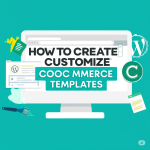How to Create and Customize WooCommerce Templates?
- 8 Jan 2025
- 0 Comments
WooCommerce is one of the most popular eCommerce platforms for WordPress, offering a wide range of customizable templates that allow you to create unique online stores. Whether you’re building a custom theme for your clients or personalizing your own store, understanding WooCommerce templates is essential.
In this blog, we’ll guide you through the process of creating and customizing WooCommerce templates to match your brand and functionality requirements.
Understanding WooCommerce Templates
WooCommerce templates are PHP files that control the layout and design of your online store. These templates determine how products, categories, cart, checkout, and other pages are displayed. WooCommerce uses a templating system that allows you to override default templates with your custom versions.
Key WooCommerce Template Files
Here are some important template files in WooCommerce:
- archive-product.php: Displays product categories or a list of products.
- single-product.php: Displays individual product details.
- cart.php: Manages the shopping cart page.
- checkout.php: Manages the checkout page.
- myaccount.php: Displays user account details and orders.
- content-single-product.php: Structures the single product page content.
Methods to Customize WooCommerce Templates
There are three primary methods to customize WooCommerce templates:
- Using a Child Theme (Recommended)
- Overriding Templates via Theme Files
- Using Hooks and Filters
Let’s explore each method in detail.
1. Using a Child Theme
A child theme ensures your customizations remain safe during WooCommerce or theme updates. Here’s how to create one:
Step 1: Create a Child Theme
- Install a plugin like Child Theme Generator or manually create a folder in
wp-content/themes/(e.g.,my-theme-child). - Add a
style.cssfile with the following header:
/*
Theme Name: My Theme Child
Template: parent-theme-folder-name
*/
- Add a
functions.phpfile to enqueue parent and child theme styles:
add_action('wp_enqueue_scripts', 'my_child_theme_styles');
function my_child_theme_styles() {
wp_enqueue_style('parent-theme-style', get_template_directory_uri() . '/style.css');
wp_enqueue_style('child-theme-style', get_stylesheet_uri());
}
Step 2: Activate the Child Theme
Go to Appearance > Themes and activate your child theme.
1. Overriding Templates via Theme Files
WooCommerce allows you to override its default templates by copying them into your child theme.
Step 1: Locate the Template to Customize
- Navigate to
wp-content/plugins/woocommerce/templates/to find default templates. - For example, to customize the product page, locate
single-product.php.
Step 2: Copy the Template to Your Child Theme
- Create a
woocommercefolder in your child theme directory. - Copy the template file (e.g.,
single-product.php) into this folder.
Step 3: Modify the Copied Template
Edit the copied file in your child theme. For example, to rearrange elements on the product page:
// Move the product title above the price
remove_action('woocommerce_single_product_summary', 'woocommerce_template_single_title', 5);
add_action('woocommerce_before_single_product_summary', 'woocommerce_template_single_title', 10);
Step 4: Test Your Changes
Visit the product page to see your modifications.
2. Creating Custom WooCommerce Templates
Sometimes, overriding is not enough—you may want to create a completely custom template for specific product types or pages.
Steps to Create a Custom Template:
- Register a Custom Template
Create a new template file in your theme and register it viaadd_filter.
add_filter( 'template_include', 'custom_product_template' );
function custom_product_template( $template ) {
if ( is_singular( 'product' ) && has_term( 'custom-category', 'product_cat' ) ) {
return get_stylesheet_directory() . '/woocommerce/single-product-custom.php';
}
return $template;
}
2 .Design Your Custom Template
Use the WooCommerce functions like woocommerce_get_template_part() or custom loops to build your layout.
3. Using Hooks and Filters
Hooks and filters let you modify WooCommerce without editing template files directly.
Common Hooks
woocommerce_before_main_content
Triggered before the main content of WooCommerce pages.woocommerce_after_shop_loop_item_title
Useful for adding elements below the product title on archive pages.woocommerce_single_product_summary
Controls the output on a single product page.
Example 1: Change the “Add to Cart” Button Text
Add this to your child theme’s functions.php:
add_filter('woocommerce_product_single_add_to_cart_text', 'custom_add_to_cart_text');
function custom_add_to_cart_text() {
return 'Buy Now'; // Replace button text
}
Example 2: Customize the Product Loop
Modify the product grid on shop pages:
// Remove sale badges
remove_action('woocommerce_before_shop_loop_item_title', 'woocommerce_show_product_loop_sale_flash', 10);
// Add a custom class to product images
add_filter('woocommerce_product_get_image', 'custom_product_image_class');
function custom_product_image_class($image) {
return str_replace('<img', '<img class="my-custom-class"', $image);
}
Template Structure & Hierarchy
WooCommerce follows a template hierarchy similar to WordPress. For example:
archive-product.php>taxonomy-product_cat.php>taxonomy.phpsingle-product.php>content-single-product.php
This allows granular control. For instance, create a taxonomy-product_cat.php file to design a specific product category page.
Advanced Customization Examples
Customize the Checkout Page
- Copy
checkout/form-checkout.phpto your child theme’swoocommercefolder. - Rearrange fields using hooks:
// Move billing email field to the top
remove_action('woocommerce_checkout_fields', 'woocommerce_checkout_billing');
add_action('woocommerce_checkout_before_customer_details', 'woocommerce_checkout_billing');
Add Custom Content to Product Pages
Insert a custom section after product descriptions:
add_action('woocommerce_after_single_product_summary', 'custom_product_section', 15);
function custom_product_section() {
echo '<div class="custom-section">This product is eco-friendly!</div>';
}
Best Practices
- Use a Child Theme: Avoid losing changes during updates.
- Document Customizations: Track changes to templates or functions.
- Test After Updates: WooCommerce updates may affect overrides.
- Use Hooks When Possible: Minimize direct template edits.
Troubleshooting
- Template Not Updating? Clear caching plugins or server cache.
- White Screen of Death? Check for PHP errors in
wp-config.phpby enabling debug mode:
define('WP_DEBUG', true);
Conclusion
Customizing WooCommerce templates empowers you to create a store that aligns perfectly with your brand. Whether you’re tweaking layouts with a child theme, leveraging hooks, or overriding template files, these methods offer endless flexibility. Always test changes in a staging environment and follow best practices to maintain a stable, future-proof store.
For further learning, explore the WooCommerce Documentation or experiment with tools like WPCodefor snippet management. Happy customizing! 🛠️




No Comment Found Yet !